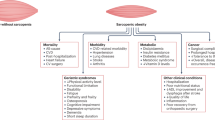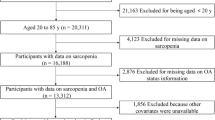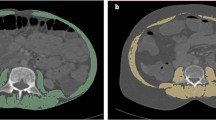Abstract
Background
Sarcopenic obesity, characterized by reduced muscle mass and excessive fat, has not been adequately studied regarding its impact on cardio-cerebrovascular disease (CCVD) and related mortality.
Objective
This systematic review and meta-analysis aimed to evaluate the relationship between sarcopenic obesity, CCVD risk, and associated mortality.
Methods
We searched PubMed, Embase, Web of Science, Cochrane Library, Chinese National Knowledge Infrastructure, WANFANG DATA, Technology Journal Database, and Chinese Biological Medical Database, considering articles from inception to April 1, 2024. Two researchers independently screened the literature, evaluated study quality, and extracted data. Both fixed- and random-effects models were used to pool the estimates of odds ratios (ORs). Publication and sensitivity bias analyses tested the robustness of associations.
Results
A total of 28 studies, comprising 575,942 participants, were included. The results demonstrated a significant association between sarcopenic obesity and an increased risk of CCVD (OR: 2.06, 95% CI: 1.70–2.48, I² = 71%; p < 0.001). Subgroup analyses further indicated that sarcopenic obesity defined by combined measures of muscle mass, muscle strength, and body mass index was associated with a 9.22-fold increased risk of CCVD, and a 2.10-fold increased risk of cardiovascular disease, but no significant association with the risk of stroke was observed. In contrast, when assessing CCVD mortality, seven studies found no significant overall association (OR: 1.58, 95% CI: 0.99–2.53, I² = 92%; p = 0.05). However, in subgroup analyses, significant associations emerged in studies with larger sample sizes (≥5000 participants; OR: 1.76, 95% CI: 1.37–2.27, p < 0.01) and longer follow-up durations (≥10 years; OR: 1.54, 95% CI: 1.16–2.04, p < 0.01).
Conclusions
Sarcopenic obesity is associated with an increased risk of CCVD, and its long-term impact on CCVD mortality may be more evident in studies with larger sample sizes and extended follow-up periods. These findings underscore the need for well-designed prospective studies employing standardized diagnostic criteria and adequate follow-up to confirm the observed associations and clarify their clinical significance.
This is a preview of subscription content, access via your institution
Access options
Subscribe to this journal
Receive 12 print issues and online access
$259.00 per year
only $21.58 per issue
Buy this article
- Purchase on SpringerLink
- Instant access to full article PDF
Prices may be subject to local taxes which are calculated during checkout



Similar content being viewed by others
References
Park MJ, Choi KM. Interplay of skeletal muscle and adipose tissue: sarcopenic obesity. Metabolism. 2023;144:155577.
Luo Y, Wang Y, Tang S, Xu L, Zhao X, Han M, et al. Prevalence of sarcopenic obesity in the older non-hospitalized population: a systematic review and meta-analysis. BMC Geriatr. 2024;24:357.
Bellanti F, Romano AD, Lo Buglio A, Castriotta V, Guglielmi G, Greco A, et al. Oxidative stress is increased in sarcopenia and associated with cardiovascular disease risk in sarcopenic obesity. Maturitas. 2018;109:6–12.
Evans K, Abdelhafiz D, Abdelhafiz AH. Sarcopenic obesity as a determinant of cardiovascular disease risk in older people: a systematic review. Postgrad Med. 2021;133:831–42.
Wei S, Nguyen TT, Zhang Y, Ryu D, Gariani K. Sarcopenic obesity: epidemiology, pathophysiology, cardiovascular disease, mortality, and management. Front Endocrinol. 2023;14:1185221.
Atkins JL, Whincup PH, Morris RW, Lennon LT, Papacosta O, Wannamethee SG, et al. Sarcopenic obesity and risk of cardiovascular disease and mortality: a population-based cohort study of older men. J Am Geriatr Soc. 2014;62:253–60.
Farmer RE, Mathur R, Schmidt AF, Bhaskaran K, Fatemifar G, Eastwood SV, et al. Associations between measures of sarcopenic obesity and risk of cardiovascular disease and mortality: a cohort study and Mendelian randomization analysis using the UK Biobank. J Am Heart Assoc. 2019;8:e011638.
Stephen WC, Janssen I. Sarcopenic-obesity and cardiovascular disease risk in the elderly. J Nutr Health Aging. 2009;13:460–6.
Liu C, Wong PY, Chung YL, Chow SK, Cheung WH, Law SW, et al. Deciphering the “obesity paradox” in the elderly: a systematic review and meta-analysis of sarcopenic obesity. Obes Rev. 2023;24:e13534.
Page MJ, McKenzie JE, Bossuyt PM, Boutron I, Hoffmann TC, Mulrow CD, et al. The PRISMA 2020 statement: an updated guideline for reporting systematic reviews. Syst Rev. 2021;10:89.
World Health Organization. 10th revision, 2nd ed. ICD-10: international statistical classification of diseases and related health problems. World Health Organization, Geneva. 2004. https://apps.who.int/iris/handle/10665/42980 (6 June 2024, last accessed).
Munn Z, Moola S, Lisy K, Riitano D, Tufanaru C. Methodological guidance for systematic reviews of observational epidemiological studies reporting prevalence and cumulative incidence data. Int J Evid Based Health. 2015;13:147–53.
Gao Q, Mei F, Shang Y, Hu K, Chen F, Ma B, et al. Global prevalence of sarcopenic obesity in older adults: a systematic review and meta-analysis. Clin Nutr. 2021;40:4633–41.
Liu H, Zhang N, Zhang J. Correlation of sarcopenic obesity with incidence of coronary heart disease and death risk in elderly patients. Chin J Geriatr Heart Brain Vessel Dis. 2023;25:680–3.
Seo HS, Lee H, Kim S, Lee SK, Lee KY, Shin C, et al. Paravertebral muscles as indexes of sarcopenia and sarcopenic obesity: comparison with imaging and muscle function indexes and impact on cardiovascular and metabolic disorders. Am J Roentgenol. 2021;216:1596–606.
Chuan F, Chen S, Ye X, Kang S, Mei M, Tian W, et al. Sarcopenic obesity predicts negative health outcomes among older patients with type 2 diabetes: the Ageing and Body Composition of Diabetes (ABCD) cohort study. Clin Nutr. 2022;41:2740–8.
Fukuda T, Bouchi R, Takeuchi T, Tsujimoto K, Minami I, Ogawa Y, et al. Sarcopenic obesity assessed using dual energy X-ray absorptiometry can predict cardiovascular disease in patients with type 2 diabetes: a retrospective observational study. Cardiovasc Diabetol. 2018;17:55.
Ikeue K, Kusakabe T, Muranaka K, Yamakage H, Inoue T, Satoh-Asahara N, et al. A combined index of waist circumference and muscle quality is associated with cardiovascular disease risk factor accumulation in Japanese obese patients: a cross-sectional study. Endocrine. 2022;77:30–40.
Kreidieh D, Itani L, El Masri D, Tannir H, Citarella R, El Ghoch M. Association between sarcopenic obesity, type 2 diabetes, and hypertension in overweight and obese treatment-seeking adult women. J Cardiovasc Dev Dis. 2018;5:51.
Chuang SY, Hsu YY, Chen RC, Liu WL, Pan WH. Abdominal obesity and low skeletal muscle mass jointly predict total mortality and cardiovascular mortality in an elderly Asian population. J Gerontol A Biol Sci Med Sci. 2016;71:1049–55.
Wang S, He S, Song G. Research on relationships between sarcopenic obesity and hypertension. Mod Prev Med. 2016;43:3053–6.
Pasdar Y, Darbandi M, Rezaeian S, Najafi F, Hamzeh B, Bagheri A. Association of obesity, sarcopenia, and sarcopenic obesity with hypertension in adults: a cross-sectional study from Ravansar, Iran during 2014-2017. Front Public Health. 2022;9:705055.
Chung GE, Park HE, Lee H, Kim MJ, Choi SY, Yim JY, et al. Sarcopenic obesity is significantly associated with coronary artery calcification. Front Med. 2021;8:651961.
Jiang M, Ren X, Han L, Zheng X. Associations between sarcopenic obesity and risk of cardiovascular disease: a population-based cohort study among middle-aged and older adults using the CHARLS. Clin Nutr. 2024;43:796–802.
Jun JE, Kang M, Jin SM, Kim K, Hwang YC, Jeong IK, et al. Additive effect of low skeletal muscle mass and abdominal obesity on coronary artery calcification. Eur J Endocrinol. 2021;184:867–77.
Jung MH, Ihm SH, Park SM, Jung HO, Hong KS, Baek SH, et al. Effects of sarcopenia, body mass indices, and sarcopenic obesity on diastolic function and exercise capacity in Koreans. Metabolism. 2019;97:18–24.
Kim JH, Cho JJ, Park YS. Relationship between sarcopenic obesity and cardiovascular disease risk as estimated by the Framingham risk score. J Korean Med Sci. 2015;30:264–71.
Shinuk K. Physical activity and cardiorespiratory fitness attenuate the impact of sarcopenic-obesity on cardiovascular disease risk in Korean men: a cross sectional study. J Mens Health. 2020;16:e39–49.
Kouvari M, Polyzos SA, Chrysohoou C, Skoumas J, Pitsavos CS, Panagiotakos DB, et al. Skeletal muscle mass and abdominal obesity are independent predictors of hepatic steatosis and interact to predict ten-year cardiovascular disease incidence: data from the ATTICA cohort study. Clin Nutr. 2022;41:1281–9.
Lee K. Sarcopenic obesity and 10-year cardiovascular disease risk scores in cancer survivors and non-cancer participants using a nationwide survey. Eur J Cancer Care. 2021;30:e13365.
Ma J, Hwang SJ, McMahon GM, Curhan GC, Mclean RR, Murabito JM, et al. Mid-adulthood cardiometabolic risk factor profiles of sarcopenic obesity. Obesity. 2016;24:526–34.
Park SH, Park JH, Song PS, Kim DK, Kim KH, Seol SH, et al. Sarcopenic obesity as an independent risk factor of hypertension. J Am Soc Hypertens. 2013;7:420–5.
Xia MF, Chen LY, Wu L, Ma H, Li XM, Li Q, et al. Sarcopenia, sarcopenic overweight/obesity and risk of cardiovascular disease and cardiac arrhythmia: a cross-sectional study. Clin Nutr. 2021;40:571–80.
Yoo JH, Park SW, Jun JE, Jin SM, Hur KY, Lee MK, et al. Relationship between low skeletal muscle mass, sarcopenic obesity and left ventricular diastolic dysfunction in Korean adults. Diab Metab Res Rev. 2021;37:e3363.
Han K, Park YM, Kwon HS, Ko SH, Lee SH, Yim HW, et al. Sarcopenia as a determinant of blood pressure in older Koreans: findings from the Korea National Health and Nutrition Examination Surveys (KNHANES) 2008-2010. PLoS ONE. 2014;9:e86902.
Kim D, Lee J, Park R, Oh CM, Moon S. Association of low muscle mass and obesity with increased all-cause and cardiovascular disease mortality in US adults. J Cachexia Sarcopenia Muscle. 2024;15:240–54.
Lee H, Chung HS, Kim YJ, Choi MK, Roh YK, Yu JM, et al. Association between body composition and the risk of mortality in the obese population in the United States. Front Endocrinol. 2023;14:1257902.
Qu Q, Guo Q, Sun J, Lu X, Cheang I, Zhu X, et al. Low lean mass with obesity in older adults with hypertension: prevalence and association with mortality rate. BMC Geriatr. 2023;23:619.
Chang SC, Yang WV. Hyperglycemia, tumorigenesis, and chronic inflammation. Crit Rev Oncol Hematol. 2016;108:146–53.
Di Pino A, DeFronzo RA. Insulin resistance and atherosclerosis: implications for insulin-sensitizing agents. Endocr Rev. 2019;40:1447–67.
Favre GA, Esnault VL, Van Obberghen E. Modulation of glucose metabolism by the renin-angiotensin-aldosterone system. Am J Physiol Endocrinol Metab. 2015;308:E435–49.
Hong SH, Choi KM. Sarcopenic obesity, insulin resistance, and their implications in cardiovascular and metabolic consequences. Int J Mol Sci. 2020;21:494.
Rungratanawanich W, Qu Y, Wang X, Essa MM, Song BJ. Advanced glycation end products (AGEs) and other adducts in aging-related diseases and alcohol-mediated tissue injury. Exp Mol Med. 2021;53:168–88.
Pal R, Bhadada SK. AGEs accumulation with vascular complications, glycemic control and metabolic syndrome: a narrative review. Bone. 2023;176:116884.
Kosmopoulos M, Drekolias D, Zavras PD, Piperi C, Papavassiliou AG. Impact of advanced glycation end products (AGEs) signaling in coronary artery disease. Biochim Biophys Acta Mol Basis Dis. 2019;1865:611–9.
Tsoporis JN, Izhar S, Leong-Poi H, Desjardins JF, Huttunen HJ, Parker TG. S100B interaction with the receptor for advanced glycation end products (RAGE): a novel receptor-mediated mechanism for myocyte apoptosis postinfarction. Circ Res. 2010;106:93–101.
Yu Y, Wei SG, Zhang ZH, Weiss RM, Felder RB. ERK1/2 MAPK signaling in hypothalamic paraventricular nucleus contributes to sympathetic excitation in rats with heart failure after myocardial infarction. Am J Physiol Heart Circ Physiol. 2016;310:H732–9.
Brailoiu E, Deliu E, Sporici RA, Brailoiu GC. Irisin evokes bradycardia by activating cardiac-projecting neurons of nucleus ambiguus. Physiol Rep. 2015;3:e12419.
Zheng K, Wang Z, Han P, Chen C, Huang C, Wu Y, et al. Lower heart rate variability is associated with loss of muscle mass and sarcopenia in community-dwelling older Chinese adults. J Formos Med Assoc. 2024;123:571–7.
Choi SJ, Files DC, Zhang T, Wang ZM, Messi ML, Gregory H, et al. Intramyocellular lipid and impaired myofiber contraction in normal weight and obese older adults. J Gerontol A Biol Sci Med Sci. 2016;71:557–64.
Wang L, Valencak TG, Shan T. Fat infiltration in skeletal muscle: influential triggers and regulatory mechanism. iScience. 2024;27:109221.
Lee HY, Choi CS, Birkenfeld AL, Alves TC, Jornayvaz FR, Jurczak MJ, et al. Targeted expression of catalase to mitochondria prevents age-associated reductions in mitochondrial function and insulin resistance. Cell Metab. 2010;12:668–74.
Munekawa C, Okamura T, Majima S, River B, Kawai S, Kobayashi A, et al. Daidzein inhibits muscle atrophy by suppressing inflammatory cytokine- and muscle atrophy-related gene expression. Nutrients. 2024;16:3084.
Delrieu L, Martin A, Touillaud M, Pérol O, Morelle M, Febvey-Combes O, et al. Sarcopenia and serum biomarkers of oxidative stress after a 6-month physical activity intervention in women with metastatic breast cancer: results from the ABLE feasibility trial. Breast Cancer Res Treat. 2021;188:601–13.
Spiegowski D, Metzger L, Jain A, Inchiosa MA Jr, Weber G, Abramowicz AE. The utility of grip strength as a simplified measure of frailty in the older adult in the preoperative clinic. Cureus. 2022;14:e28747.
Zhong BX, Zhong HL, Zhou GQ, Xu WQ, Lu Y, Zhao Q. Physical performance and risk of hip fracture in community-dwelling elderly people in China: a 4-year longitudinal cohort study. Maturitas. 2021;146:26–33.
Cruz-Jentoft AJ, Bahat G, Bauer J, Boirie Y, Bruyère O, Cederholm T, et al. Sarcopenia: revised European consensus on definition and diagnosis. Age Ageing. 2019;48:16–31.
Chen LK, Woo J, Assantachai P, Auyeung TW, Chou MY, Iijima K, et al. Asian Working Group for Sarcopenia: 2019 consensus update on sarcopenia diagnosis and treatment. J Am Med Dir Assoc. 2020;21:300–7.e2.
Lim S, Kim JH, Yoon JW, Kang SM, Choi SH, Park YJ, et al. Sarcopenic obesity: prevalence and association with metabolic syndrome in the Korean Longitudinal Study on Health and Aging (KLoSHA). Diab Care. 2010;33:1652–4.
Liu M, Zhang Z, Zhou C, Ye Z, He P, Zhang Y, et al. Predicted fat mass and lean mass in relation to all-cause and cause-specific mortality. J Cachexia Sarcopenia Muscle. 2022;13:1064–75.
Lee DH, Keum N, Hu FB, Orav EJ, Rimm EB, Willett WC, et al. Predicted lean body mass, fat mass, and all cause and cause specific mortality in men: prospective US cohort study. BMJ. 2018;362:k2575.
Lim U, Ernst T, Buchthal SD, Latch M, Albright CL, Wilkens LR, et al. Asian women have greater abdominal and visceral adiposity than Caucasian women with similar body mass index. Nutr Diab. 2011;1:e6.
Coz E, Fauvernier M, Maucort-Boulch D. An overview of regression models for adverse events analysis. Drug Saf. 2024;47:205–16.
Hill KG, Woodward D, Woelfel T, Hawkins JD, Green S. Planning for long-term follow-up: strategies learned from longitudinal studies. Prev Sci. 2016;17:806–18.
Noubiap JJ, Balti EV, Bigna JJ, Echouffo-Tcheugui JB, Kengne AP. Dyslipidaemia in Africa-comment on a recent systematic review—Authors’ reply. Lancet Glob Health. 2019;7:e308–9.
Funding
The work was supported by the Capital Clinical Diagnosis and Treatment Technology Research and Translational Application Project (Grant No. Z201100005520006) and the Nursing Research Project of the Affiliated Hospital of Guizhou Medical University (Grant No. gyfyhl-2024-A20).
Author information
Authors and Affiliations
Contributions
Study concept and design: Yuhong Luo, Lingzhi Shu, and Binru Han. Acquisition of data: Xinyu Zhao, Mengya Han, Yuhua Liu, and Yan Xu. Analysis and interpretation of data: Yuhong Luo and Lingzhi Shu. Preparation of manuscript: Yuhong Luo, Lingzhi Shu, and Yanqiu Wang. The contributions of Yuhong Luo and Lingzhi Shu to this study were equal. All authors commented on previous versions of the manuscript. All authors read and approved the final manuscript.
Corresponding author
Ethics declarations
Competing interests
The authors declare no competing interests.
Additional information
Publisher’s note Springer Nature remains neutral with regard to jurisdictional claims in published maps and institutional affiliations.
Supplementary information
Rights and permissions
Springer Nature or its licensor (e.g. a society or other partner) holds exclusive rights to this article under a publishing agreement with the author(s) or other rightsholder(s); author self-archiving of the accepted manuscript version of this article is solely governed by the terms of such publishing agreement and applicable law.
About this article
Cite this article
Luo, Y., Shu, L., Wang, Y. et al. Sarcopenic obesity and risk of cardio-cerebrovascular disease and mortality: a systematic review and meta-analysis. Int J Obes (2025). https://doi.org/10.1038/s41366-025-01909-z
Received:
Revised:
Accepted:
Published:
DOI: https://doi.org/10.1038/s41366-025-01909-z



